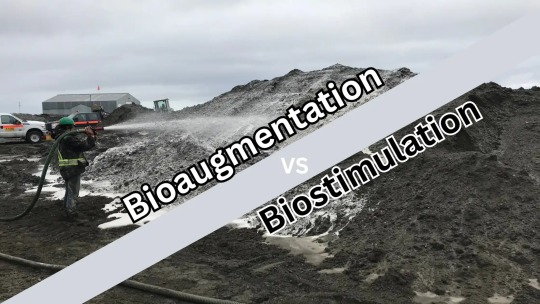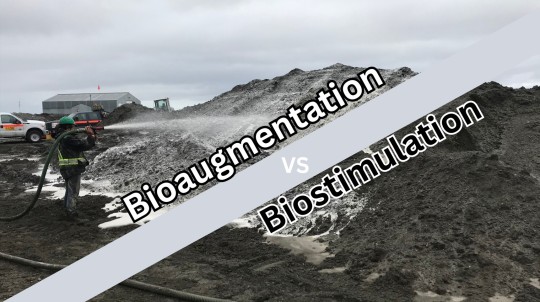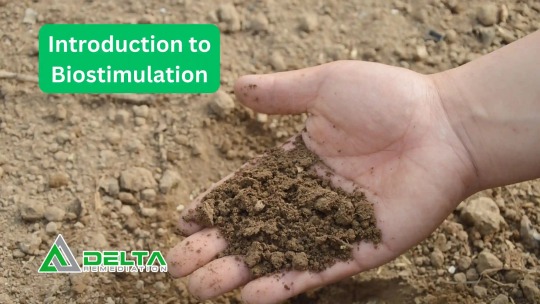#Bioaugmentation vs Biostimulation
Explore tagged Tumblr posts
Text

Unraveling the Depths of Bioaugmentation and Biostimulation: A Comprehensive Comparison
Introduction:
If you've ever delved into the field of environmental biotechnology, you've likely stumbled across the terms "bioaugmentation" and "biostimulation". These sophisticated approaches to environmental remediation are both aimed at enhancing natural processes to treat contamination. But what exactly distinguishes one from the other? In this article, we will delve into the specifics of Bioaugmentation vs Biostimulation, breaking down their definitions, applications, and key differences.
Understanding Bioaugmentation:
Bioaugmentation, in its simplest form, is the introduction of a group of natural microbial strains or a genetically engineered variant into an environment to enhance the rate of pollutant degradation. These microbial strains, often referred to as 'augments', are known for their specialized ability to degrade contaminants that the existing microbial community cannot effectively handle. This technique is frequently employed to address the contamination of soil and water bodies with organic pollutants such as oil spills and certain types of industrial waste.
Diving into Biostimulation:
On the other hand, biostimulation involves the stimulation of indigenous microbial communities already present in the environment by providing nutrients, electron acceptors, or substrates that enhance their activity. Unlike bioaugmentation that adds new organisms to an ecosystem, biostimulation works with the existing microbial population, encouraging their growth and pollutant degradation capabilities. Often used in environmental cleanup efforts, biostimulation can enhance the breakdown of a broad range of pollutants, including petroleum hydrocarbons and heavy metals.
Bioaugmentation Vs Biostimulation: A Comparative Study:
Now that we understand the fundamentals of both processes, it's time to compare them head-to-head.
Techniques Involved: While bioaugmentation is about introducing specific microbial strains to boost pollutant degradation, biostimulation works by providing necessary nutrients or substrates to stimulate the indigenous microbial population.
Scope of Application: Both techniques are used in environmental remediation, especially for soil and groundwater. Bioaugmentation has a slight edge in cases where specific contaminants require particular microbial strains for degradation. Biostimulation, however, is often favored for broader applications, given that it enhances the overall microbial activity and not just that of specific strains.
Economic Aspects: Bioaugmentation requires the cultivation and addition of specific microbial strains, which can be costly and technically demanding. On the contrary, biostimulation usually involves adding relatively inexpensive nutrients or substrates, making it a more economically feasible option in many cases.
Environmental Impact: Bioaugmentation involves adding new organisms, which raises concerns about the impact on the existing ecosystem and the potential for creating imbalances. Biostimulation, working with existing microbial communities, is generally viewed as having a less disruptive impact on ecosystem balance.
Effectiveness: Both techniques have proven effective in various scenarios, but their success heavily depends on site-specific conditions. For instance, bioaugmentation's effectiveness might be hindered by the inability of the added microbes to survive in the new environment. Biostimulation's success, on the other hand, could be limited by the potential growth of undesired microbial communities.
Conclusion:
Bioaugmentation and biostimulation, though conceptually distinct, share a common goal: to utilize biological processes for environmental remediation. Choosing between them demands a clear understanding of the contamination at hand, the existing microbial community, and the economic and environmental implications of each approach. As scientists continue to explore these fascinating techniques, our ability to heal the environment using nature's own tools will only continue to improve.
#Bioaugmentation#Biostimulation#Bioremediation technologies#Environmental Remediation#Pollution control methods#Bioaugmentation vs Biostimulation#Benefits of bioaugmentation#Benefits of biostimulation#Bioaugmentation in habitat restoration#Biostimulation for pollution control#Limitations of bioaugmentation#Limitations of biostimulation#Bioaugmentation-assisted biostimulation#Microbial bioremediation#Sustainable environmental practices#Choosing between bioaugmentation and biostimulation#Understanding bioaugmentation#Understanding biostimulation#Industrial waste management#Oil spill cleanup techniques
5 notes
·
View notes
Text

Bioaugmentation Versus Biostimulation: Decoding Key Environmental Bioremediation Strategies
Introduction
Bioaugmentation and biostimulation stand as revolutionary strategies in the realm of environmental biotechnology. How do these terms define themselves and what sets them apart?
An In-Depth Look into Bioaugmentation and Biostimulation
Bioaugmentation and biostimulation, both employing living organisms, play pivotal roles in purifying polluted environments, be it soil or water. However, their modus operandi in achieving this feat greatly varies.
Delving into Bioaugmentation
Let's first navigate through the fascinating world of bioaugmentation.
Bioaugmentation Explained: Definition and Procedure
Bioaugmentation involves introducing specially cultured microorganisms to a polluted environment to expedite the degradation of pollutants. Think of it as adding specific ingredients (including microbes) into a bread recipe – by controlling the components, environmental experts can predict the outcome.
Why Choose Bioaugmentation: Key Advantages
Bioaugmentation opens up the possibility to degrade a diverse array of pollutants, thereby enhancing the pace of pollution degradation.
Bioaugmentation: Identifying the Challenges
Despite its benefits, bioaugmentation faces certain hurdles. The primary drawback is the higher cost involved in introducing a culture compared to simply adding nutrients.
Unfolding the Concept of Biostimulation
Now, let's shift our focus to biostimulation.
Unraveling Biostimulation
Biostimulation is a process where nutrients and other substances are added to boost the growth of native microorganisms, thereby aiding in the degradation of pollutants. It's akin to providing an energy drink to the local cleanup team!
Why Opt for Biostimulation: Core Advantages
Biostimulation capitalizes on existing microbial communities, causes less disturbance to the ecosystem, and proves efficient in treating large-scale contaminations.
Understanding Biostimulation Limitations
However, biostimulation has its drawbacks, such as unpredictable outcomes and a longer duration for the degradation process compared to bioaugmentation.
Bioaugmentation and Biostimulation: A Side by Side Comparison
Next, we draw a comparison between these two strategies.
Common Ground
Both strategies share a common goal - degrading pollutants through microorganisms. Moreover, they are generally more eco-friendly and sustainable than their chemical counterparts.
Crucial Distinctions
The fundamental distinction lies in their respective strategies - bioaugmentation introduces new microorganisms, while biostimulation boosts the activity of existing ones.
Case Studies: Witnessing Bioaugmentation and Biostimulation at Work
Imagine an oil spill scenario. Here, bioaugmentation might involve introducing oil-consuming bacteria, while biostimulation might add nutrients to spur the growth of local oil-consuming bacteria.
Deciding Between Bioaugmentation and Biostimulation
Selecting between these two strategies hinges on multiple factors, including the type of pollution, site characteristics, and available resources.
Looking Ahead: The Future of Bioaugmentation and Biostimulation
As the quest for sustainable and effective pollution control continues, the significance of both bioaugmentation and biostimulation is set to rise.
Conclusion
Although different in their approach, both bioaugmentation and biostimulation serve as instrumental tools in combating environmental pollution. Comprehending these differences is integral for informed decision-making in the field of environmental bioremediation.
#Bioaugmentation#Biostimulation#Environmental Bioremediation#Pollution Control#Bioremediation Techniques#Sustainable Pollution Cleanup#Bioaugmentation vs Biostimulation#Microbial Pollution Degradation#Biotechnology Solutions#Eco-friendly Remediation Techniques
0 notes
Text

Unleashing the Power of Biostimulation: A Blueprint to Soil Microbe Optimization for Effective Pollution Treatment
Unmasking Biostimulation
Biostimulation is a cutting-edge application in environmental science, drawing upon the potency of natural processes to rectify man-induced predicaments such as soil pollution.
Deciphering Biostimulation
The heart of biostimulation lies in augmenting the indigenous microbial population dwelling within the soil. This bioremediation process fosters the expansion and functionality of these native microbes, enabling them to degrade organic pollutants with increased efficiency.
The Biostimulation Phenomenon
The DNA of Biostimulation
Biostimulation's lifeblood is to furnish an optimum habitat for microbes. When placed under perfect conditions, these tiny organisms can skillfully dismantle pollutants.
The Biostimulation Blueprint
The biostimulation procedure springs into action with an examination of the soil, quantifying the microbial presence and the degree of contamination. Following this evaluation, a tailored biostimulation strategy is concocted and executed, typically involving nutrient enrichment or other stimulating additives.
Microbes: The Unsung Heroes of Biostimulation
Microorganisms, predominantly bacteria, are the linchpins in the biostimulation system. These minute entities, ubiquitous in the soil, possess the capability to dismantle various pollutants under favorable circumstances.
The Tools of Biostimulation
Nutrient Infusion
Like all life forms, microbes demand nutrients to prosper. Supplying them with nitrogen, phosphorus, potassium, and other essential micronutrients can amplify their populace and metabolic vigor.
Emulsified Vegetable Oils
These oils serve as a gradual carbon source, fostering sustained microbial activity in the soil.
Regulation of Moisture and Air
Microbial decomposition often necessitates water and oxygen. Therefore, moisture and air are intermittently pumped into the polluted soil to promote microbial activity.
The Upsides of Biostimulation
Biostimulation proves to be a cost-efficient and eco-friendly strategy. It harnesses nature’s own janitorial squad, thereby negating the use of damaging chemical treatments or costly mechanical extractions.
The Variables in Biostimulation
The triumph of biostimulation is hinged on numerous aspects, including the soil's properties, the contaminants' character, and the native microbial populace. This necessitates exhaustive preliminary evaluations as a universal approach would not suffice.
Biostimulation vs Bioaugmentation
While biostimulation centers on boosting the native microbial community, bioaugmentation is a complementary process that imports specialized microbes into the soil to expedite the degradation procedure.
Biostimulation in the Real World
Spotlight on Biostimulation
Biostimulation has displayed its efficacy in addressing oil spills, industrial waste leaks, and even fallout from nuclear calamities. It is also being probed in the realm of agriculture for superior soil fertility management and pest deterrence.
Biostimulation: The Road Ahead
Amid escalating environmental concerns, biostimulation harbors immense potential. Progress in research and technological advancements might soon canonize this method as a mainstream practice for soil decontamination.
Epilogue Indeed, biostimulation serves as a natural, cost-effective, and efficient antidote to soil pollution. As we journey towards a greener future, employing the prowess of microbes via biostimulation will be instrumental in safeguarding our environment.
Frequently Asked Questions
What underpins biostimulation? Biostimulation pivots on the enhancement of the soil's native microbial community to dismantle organic pollutants.
What influences biostimulation's success rate? Aspects such as soil type, contaminant nature, and the regional microbial population shape the success of biostimulation.
How does biostimulation square up to bioaugmentation? Biostimulation focuses on stimulating the existing microbial community, while bioaugmentation brings specialized microbes into the soil.
What are the common applications of biostimulation? Biostimulation has found utility in handling oil spills, industrial waste leaks, and in agriculture for maintaining soil fertility and pest control.
What lies in store for biostimulation? With mounting environmental apprehensions, biostimulation is poised to become a standard operation for soil decontamination.
#Biostimulation in Environmental Science#Soil Microbe Optimization#Effective Pollution Treatment#Natural Remediation Methods#Biostimulation vs Bioaugmentation#Bioremediation Process#Soil Decontamination Techniques#Microbial Role in Pollution Treatment#Organic Pollutants Degradation#Cost-Effective Soil Remediation#Biostimulation in Agriculture#Eco-friendly Pollution Remediation#Role of Microorganisms in Soil Health#Nutrient Enrichment in Soil#Biostimulation in Industrial Waste Management#Soil Fertility and Pest Deterrence#Soil's Native Microbial Community#Biostimulation for Oil Spill Treatment#Sustainable Soil Decontamination Methods#Biostimulation and Soil Health
0 notes